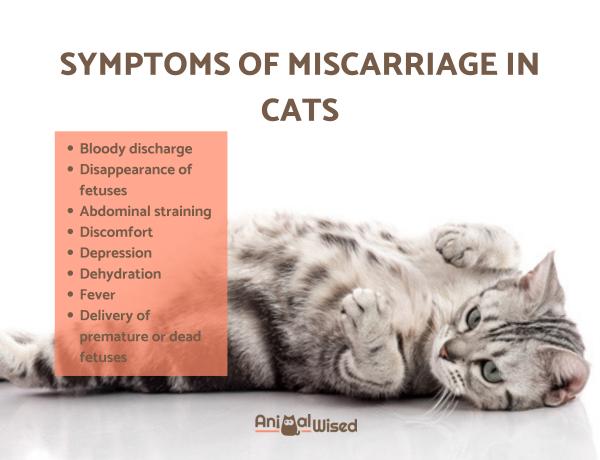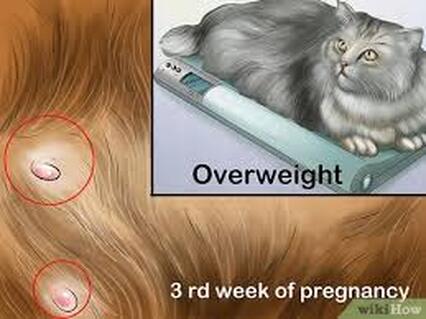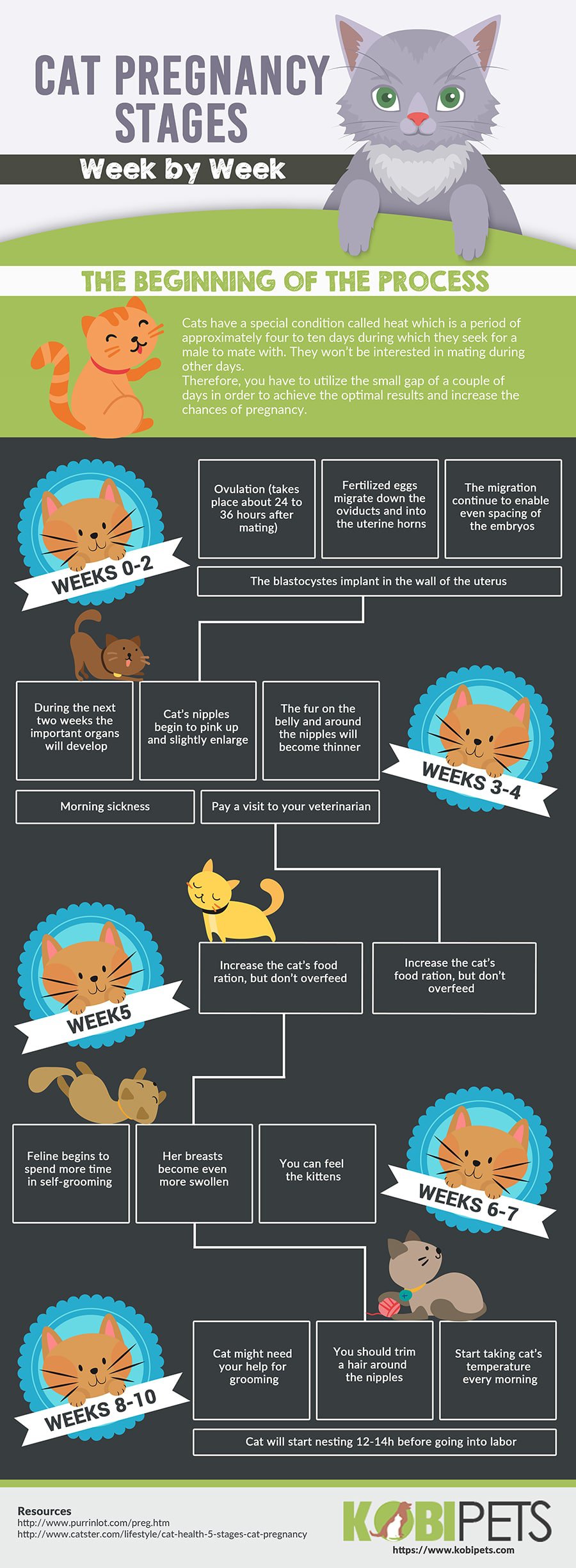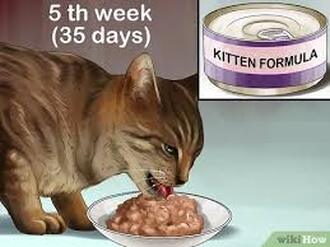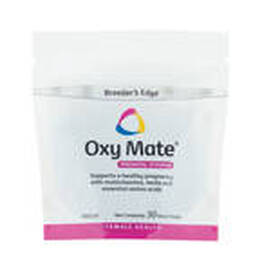Pregnancy
|
PSEUDO-PREGNANCY:
Results when a Queen has been induced to ovulate but failed to conceive. Very rare. Has all the same hallmark signs of pregnancy. Causes:
|
|
MISCARRIAGE:
Causes: Infection (viral, bacterial, parasitic), hormonal shift/abnormality (low progesterone levels) Symptoms: Can occur at any time during pregnancy, though the signs of miscarriage vary depending on the stage at which miscarriage occurs. When early (1-45 days): The embryo is often reabsorbed into the body and the miscarriage may go completely undetected. In some cases, one or more kittens in the litter may be miscarried and resorbed, while other kittens in the litter go on to be born normally. |
When later (46-65 days):
Result in a variety of outcomes. Kittens may be passed stillborn, either before their due date or on their due date. In some cases, a deceased fetus may become mummified within the uterus. Mummification occurs when the body creates a protective membrane around the fetus, allowing it to remain encased and walled-off within the uterus. In many cases, mummification does not pose any threat to the female; in some situations, however, infection may occur.
Other signs: Abnormal vaginal discharge (brown, green, black, or pus-colored) at any time during pregnancy, abdominal pain, and fever are all potential signs of miscarriage or infection, & contractions to deliver stillborn kittens.
Treatment/Prevention:
If a cat develops a fever during pregnancy, this may indicate an infection. Infections are typically treated with intravenous (IV) fluids and injectable antibiotics. This may prevent miscarriage or, if miscarriage has already occurred, may prevent more severe medical complications with the mother.
If hormonal imbalances are suspected, a progesterone supplement may be recommended. This medication is given daily until shortly before the expected due date, in order to help maintain appropriate hormone levels to support pregnancy. This medication requires careful monitoring in order to prevent complications.
*From an article by: Catherine Barnette, DVM
Result in a variety of outcomes. Kittens may be passed stillborn, either before their due date or on their due date. In some cases, a deceased fetus may become mummified within the uterus. Mummification occurs when the body creates a protective membrane around the fetus, allowing it to remain encased and walled-off within the uterus. In many cases, mummification does not pose any threat to the female; in some situations, however, infection may occur.
Other signs: Abnormal vaginal discharge (brown, green, black, or pus-colored) at any time during pregnancy, abdominal pain, and fever are all potential signs of miscarriage or infection, & contractions to deliver stillborn kittens.
Treatment/Prevention:
If a cat develops a fever during pregnancy, this may indicate an infection. Infections are typically treated with intravenous (IV) fluids and injectable antibiotics. This may prevent miscarriage or, if miscarriage has already occurred, may prevent more severe medical complications with the mother.
If hormonal imbalances are suspected, a progesterone supplement may be recommended. This medication is given daily until shortly before the expected due date, in order to help maintain appropriate hormone levels to support pregnancy. This medication requires careful monitoring in order to prevent complications.
*From an article by: Catherine Barnette, DVM
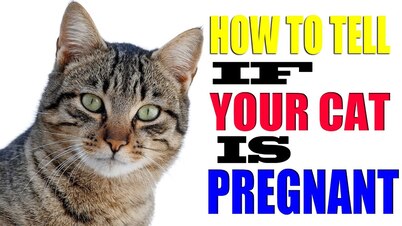
Signs Your Cat Is Pregnant:
- Heat Cycle Change: Your cat will normally have a heat cycle every 10 days to two weeks. This is often accompanied by yowling or rolling on the floor. This will stop when she gets pregnant.
- Increased Appetite: Your pregnant “queen” will likely desire more food during this time (about 1.5 times her normal diet), as she’s not only feeding herself.
- Darkened Nipples: The cat’s nipples will swell and “pink up” in color. They might look darker and fully engorged, especially if she’s had more than one litter. It might not be easy to tell under a layer of dark fur, however.
- Vomiting: Morning sickness is common for both humans and cats. Regular vomiting may be a sign that she’s pregnant early on. On the other hand, if your cat is continuously doing this with all its food and there aren’t other indications of pregnancy, it may be a sign of other severe issues.
- Weight Gain: Especially later on in the gestation period, owners will often notice a two- to four-pound weight gain.
- Longer Sleep Periods: Your cat will want to stay asleep for longer periods of time.
- Affectionate Behavior: Many pet owners say that they notice an increase in affectionate behavior. You may notice your pet seeking out your attention more frequently. This is due to hormonal and neurological changes.
- Nesting Behavior: Cats prepare for birth by finding secluded, quiet places to have their litter. Your cat may even start arranging blankets or being feisty with other animals about her space.
- Swollen Abdomen: Halfway through your cat’s gestation period, she’ll show physical signs of being pregnant. This distortion may be harder to see on overweight cats.
|
How to Know If Your Cat Is Pregnant for Certain
|
|
DUE DATE DETERMINATION:
Absolute first possible due date should be 9 weeks (63 days) from the first date of mating. However, since mating can occur over many days the actual due date could be many days from this first possible date. A more accurate due date could be determine from the time the Queens nipples change color from white to pink. That usually marks the day the Queen is 3 weeks pregnant. Nipples will enlarge and swell later, but the color change is usually the first indication. |
|
FEEDING A PREGNANT QUEEN:
1. Switch your cat to a wet kitten food. Towards the midpoint of your cat’s pregnancy, begin switching her onto a high-quality wet kitten food. Kitten food contains higher percentages of nutrients and vitamins than do adult cat foods, and will provide the queen with more of the protein and calories she needs during pregnancy.[1]
|
2. Mix protein into your cat’s normal food. During the early and middle stages of pregnancy, your cat can keep primarily eating their typical food. However, you should mix in added protein to help facilitate healthy kitten growth. Do this by boiling small pieces of chicken, beef, fish, or egg and adding them to your cat’s dry or wet food. Cats can be picky eaters, and pregnant ones especially so. Try different proteins until you find one your cat prefers.
3. Give your cat constant access to food. As the pregnancy progresses and the litter of kittens take up more space inside of her, your queen will eat smaller and smaller meals, but her meals will also become more frequent. So, make sure that food is always available for your cat when she’s hungry. Rather than feeding her at specific meal times, you can leave food sitting out.[3]
- The added protein will also give the mother cat strength and energy as her body grows the kittens.
- Throughout the pregnancy and nursing period, the mother will need plenty of protein.
3. Give your cat constant access to food. As the pregnancy progresses and the litter of kittens take up more space inside of her, your queen will eat smaller and smaller meals, but her meals will also become more frequent. So, make sure that food is always available for your cat when she’s hungry. Rather than feeding her at specific meal times, you can leave food sitting out.[3]
- Wet food may go bad if left out too long. You can avoid this problem by putting out a small portion of wet food and waiting until your cat eats it, then putting out more.

